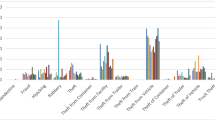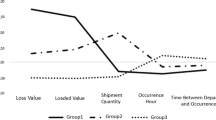Abstract
This paper identifies patterns and trends in cargo theft by analysing seasonal variations (by time of year and time of week) in the relationship between value (reported stolen value) and various reported modi operandi. This research is exploratory in nature; it is based on theories derived from criminology and logistics as well as secondary data related to cargo theft. For practical purposes, the research is geographically limited to EMEA; however, the frame of reference is applicable to the analysis of antagonistic threats to transport worldwide. Though patterns differ across categories, for some modi operandi, seasonal patterns are found across both months of the year and days of the week. Despite variations in hot spots, incident categories, stolen and endangered objects, and handling methods, the basic theoretical framework is generally applicable. This research is limited by the content and classificatory scheme of the TAPA EMEA IIS database. However, this is the best available database and it contains anonymous reports that are mainly from TAPA member companies that are in the industry itself.

Similar content being viewed by others
References
Anderson B (2007) Securing the supply chain—Prevent cargo theft. Security 5(44):56–58
Barth S, White MD (1998) Hazardous cargo. World Trade, November 1998, pp. 29
Baumer E, Wright R (1996) Crime seasonality and serious scholarship: a comment on Farrell and Pease. Br J Criminol 36:579
Beck A (2002) Automatic product identification and shrinkage: scoping the potential. ECR Europe, Brussels
Bodman P, Maultby C (1997) Crime, punishment and deterrence in Australia. Int J Soc Econ 24:884–901
Clarke RV (1995) Situational crime prevention. In: Tonry M, Farrington DP (eds) Building a safer society: strategic approaches to crime prevention. University of Chicago Press, Chicago
Clarke RV, Cornish D (2003) Opportunities, precipitators and criminal decisions: a reply to Wortley’s critique of situational crime prevention. Crime Prev Stud 16:41–96
Cohen J (1941) The geography of crime. Annals, pp. 217
Cohen LE, Felson M (1979) Social change and crime rate trends: a routine activity approach. Am Sociol Rev 44:588–608
Ekwall D (2009) Managing the risk of antagonistic threats against the transport network, dissertation, Division of Logistics and Transportation, Chalmers University of Technology: Gothenburg, Sweden
Ekwall D (2012) Antagonistic threats against supply chain activities are wicked problems. J Transp Secur 5(2):123–140
Ekwall D, Lantz B (2012) Value and incident categories for cargo theft in Europe—Analysing TAPA EMEA statistics. In the Proceedings of Nofoma 2012, Naantali, Finland
Ekwall D, Lantz B (2013) Seasonality of cargo theft at transport chain locations. Int J Phys Distrib Logist Manag 43(9):728–746
Ekwall D, Lantz B (2015) Cargo theft at non-secure parking locations. Int J Retail Distrib Manag 43(3):204–220
Europol (2009) Cargo theft report: Applying the brakes to road cargo crime in Europe. Europol, The Hague
Falk JJ (1952) The influence of the seasons on the crime rate. J Crime Law Criminol 43:199–213
Felson M (1987) Routine activities and crime prevention in the developing metropolis. Criminology 25(4):911–932
Felson M, Clarke RV (1998) Opportunity makes the thief: practical theory for crime prevention. Home Office Police and Reducing Crime Unit, London
Gorr W, Olligschlaeger A, Thompson Y (2003) Short-term forecasting of crime. Int J Forecast 19:579–594
Hylleberg S (ed) (1995) Modelling seasonality. Oxford University Press, Oxford
Kallis, Vanier (1985) (op cit.) Hayes R. (1997) Shop theft: an analysis of apprehended shoplifters. Secur J 7:11–14
Khan O, Bernard B (2007) Risk and supply chain management: creating a research agenda. Int J Logist Manag 18(2):197–216
Klemke L (1992a) The sociology of shoplifting: boosters and snitches today. Praeger, New York
Klemke (1992-B) (op cit.) Shapland J (1995) Preventing retail sector crimes. In: Tonry M and Farrington D (eds) Building a safer society: Strategic approaches to crime prevention, Chicago: University of Chicago Press
Kroneberg C, Heintze I, Mehlkop G (2010) The interplay of moral norms and instrumental incentives in crime causation. Criminology 48(1):259–294
Manuj I, Mentzer JT (2008) Global supply chain risk management. J Bus Logist 29(1):133–155
Muir J (1996) Theft at work. Work Study 45
Norrman A, Jansson U (2004) Ericsson’s proactive supply chain risk management approach after a serious sub-supplier accident. Int J Phys Distrib Logist Manag 34(5):434–456
Rabinovich E, Cheon S (2011) Expanding horizons and deepening understanding via the use of secondary data sources. J Bus Logist 32(4):303–316
Reppetto TA (1974) Residential crime. Cambridge
Sherman LW, Gartin PR, Buerger ME (1989) Hot spots of predatory crime: routine activities and the criminology of place. Criminology 27(1):27–55
Smith WR, Frazee SG, Davison EL (2000) Furthering the integration of routine activity and social disorganization theories: small units of analysis and the study of street robbery as a diffusion process. Criminology 38(2):489–523
Stock JR (1997) Applying theories from other disciplines to logistics. Int J Phys Distrib Logist Manag 27(9):515–539
TAPA http://www.tapaemea.com/intelligence/iis-data-resources/how-to-report-your-incidents.html. Accessed 13 Jun 2013
Tryon G, Kleiner B (1997) How to investigate alleged employee theft properly. Manag Audit J 12
Tummala R, Schoenherr T (2011) Assessing and managing risks using the supply chain risk management process (SCRMP). Supply Chain Manag: Int J 16(6):474–483
Wagner SM, Bode C (2008) An empirical examination of supply chain performance along several dimensions of risk. J Bus Logist 29(1):307–325
Weaver F, Carroll J (1985) Crime perceptions in a natural setting by expert and novice shoplifters. Soc Psychol Q 48(4):139–359
Acknowledgments
The authors thank the TAPA EMEA (www.tapaemea.com) for allowing us to use the data in their IIS database for this research. The authors are named alphabetically and are equally responsible for all matters within this paper.
Author information
Authors and Affiliations
Corresponding author
Rights and permissions
About this article
Cite this article
Ekwall, D., Lantz, B. Modi operandi for cargo theft in EMEA—A seasonality analysis. J Transp Secur 8, 99–113 (2015). https://doi.org/10.1007/s12198-015-0160-z
Received:
Accepted:
Published:
Issue Date:
DOI: https://doi.org/10.1007/s12198-015-0160-z




